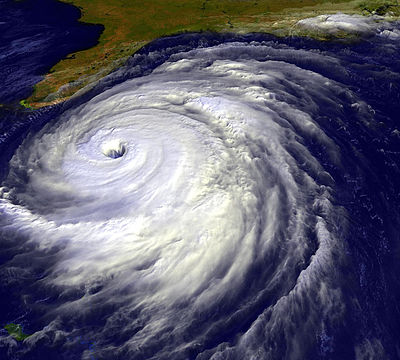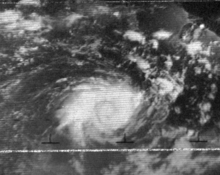Portal:Tropical cyclones
The Tropical Cyclones Portal

A tropical cyclone is a storm system characterized by a large low-pressure center, a closed low-level circulation and a spiral arrangement of numerous thunderstorms that produce strong winds and heavy rainfall. Tropical cyclones feed on the heat released when moist air rises, resulting in condensation of water vapor contained in the moist air. They are fueled by a different heat mechanism than other cyclonic windstorms such as Nor'easters, European windstorms and polar lows, leading to their classification as "warm core" storm systems. Most tropical cyclones originate in the doldrums, approximately ten degrees from the Equator.
The term "tropical" refers to both the geographic origin of these systems, which form almost exclusively in tropical regions of the globe, as well as to their formation in maritime tropical air masses. The term "cyclone" refers to such storms' cyclonic nature, with anticlockwise rotation in the Northern Hemisphere and clockwise rotation in the Southern Hemisphere. Depending on its location and intensity, a tropical cyclone may be referred to by names such as "hurricane", "typhoon", "tropical storm", "cyclonic storm", "tropical depression" or simply "cyclone".
Types of cyclone: 1. A "Typhoon" is a tropical cyclone located in the North-west Pacific Ocean which has the most cyclonic activity and storms occur year-round. 2. A "Hurricane" is also a tropical cyclone located at the North Atlantic Ocean or North-east Pacific Ocean which have an average storm activity and storms typically form between May 15 and November 30. 3. A "Cyclone" is a tropical cyclone that occurs in the South Pacific and Indian Oceans.
Selected named cyclone -
Severe Tropical Cyclone Tracy was a small tropical cyclone that devastated the city of Darwin, in the Northern Territory of Australia, in December 1974. The small, developing, easterly storm was originally expected to pass clear of the city, but it would turn towards it early on 24 December. After 10:00 p.m. ACST, damage became severe, with wind gusts reaching 217 km/h (117 kn; 135 mph) before instruments failed. The anemometer in Darwin Airport control tower had its needle bent in half by the strength of the gusts.
Residents of Darwin were celebrating Christmas, and they did not immediately acknowledge the emergency, partly because they had been alerted to an earlier cyclone (Selma) which passed west of the city, not affecting it in any way. Additionally, news outlets had only a skeleton crew on duty over the holiday. (Full article...)Selected article -
The effects of Hurricane Dean in the Lesser Antilles were spread over five island countries and included 3 fatalities. Hurricane Dean formed in the Atlantic Ocean west of Cape Verde on August 14, 2007. The National Hurricane Center's first Forecast Advisory on the system anticipated that the Cape Verde-type hurricane would pass into the Caribbean through the Lesser Antilles. The storm moved persistently towards the small island chain, strengthening until it passed through the islands three days later on August 17 as a Category 2 hurricane on the Saffir-Simpson Hurricane Scale. It went on to brush the island of Jamaica and reached Category 5 strength before making landfall on Mexico's Yucatán Peninsula.
While crossing the Lesser Antilles, Dean caused moderate damage in St. Lucia, Martinique, and Dominica, where it washed out roads, damaged houses, and killed 6 people. It also devastated the agriculture-dependent economies of those three states, as well as that of Guadeloupe, destroying between 80% and 100% of the banana crops. Deaths were reported as far away as Trinidad. (Full article...)Selected image -

Selected season -

The 2019 Pacific hurricane season was an above average season which produced nineteen named storms, most of which were rather weak and short-lived. Only seven hurricanes formed, the fewest since 2010. The season officially began on May 15 in the East Pacific Ocean, and on June 1 in the Central Pacific; they both ended on November 30. These dates conventionally delimit the period of each year when most tropical cyclones form in the Pacific basin. This season was one of the latest-starting Pacific hurricane seasons on record (reliable records began in 1971), with the first tropical cyclone, Hurricane Alvin, forming on June 25. The final system, Tropical Depression Twenty-One-E, dissipated on November 18.
The season had a rather slow start, with no cyclones forming in the basin before the month of June for the first time since 2011. The strongest hurricane of the season, Barbara, formed on June 30 and peaked as a high-end Category 4 hurricane on July 3. August was extremely quiet with no hurricanes forming during the month, a first for a season since 1973. September was much more active with six systems developing, of which three became hurricanes. Activity decreased appreciably in October and November as most of the storms remained weak and short-lived. (Full article...)Related portals
Currently active tropical cyclones

Italicized basins are unofficial.
- North Atlantic (2024)
- No active systems
- East and Central Pacific (2024)
- No active systems
- West Pacific (2024)
- No active systems
- North Indian Ocean (2024)
- No active systems
- Mediterranean (2023–24)
- No active systems
- South-West Indian Ocean (2023–24)
- No active systems
- Australian region (2023–24)
- No active systems
- South Pacific (2023–24)
- No active systems
- South Atlantic (2023–24)
- No active systems
Last updated: 21:50, 2 June 2024 (UTC)
Tropical cyclone anniversaries

June 6
- 1994 - Tropical Storm Russ moved across Hainan Island and southern China, killing 72 people and leaving US$727.5&bsp;million in damage.
- 1999 - Typhoon Maggie made landfall in China, and along its path the storm killed nine people.
- 2012 - Tropical Storm Kuena (pictured) became a rare June tropical storm in the South-West Indian Ocean.

June 7,
- 1973 - Hurricane Ava reached its peak intensity as a Category 5 hurricane, becoming the only Pacific hurricane to attain that intensity in the month of June.
- 2003 - Cyclone Gina (pictured) reaches its peak intensity as a Category 3 severe tropical cyclone after affecting the Solomon Islands with only minimal damages.

June 8
- 1960 - Typhoon Mary struck Hong Kong, killing 1,649 people across southeastern China.
- 1966 - Hurricane Alma made landfall in western Cuba causing severe flooding. The storm killed a total of 90 people and caused over $200 million of damage.
Did you know…




- …that the Joint Typhoon Warning Center considers that Typhoon Vera (pictured) of 1986 is actually two distinct systems, formed from two separated low-level circulations?
- …that Hurricane Agatha (pictured) was the strongest Pacific hurricane to make landfall in Mexico in May since records began in 1949?
- …that Cyclone Raquel (track pictured) travelled between the Australian and South Pacific basins between the 2014–15 and 2015–16 seasons, spanning both seasons in both basins?
- …that Cyclone Amphan (pictured) in 2020 was the first storm to be classified as a Super Cyclonic Storm in the Bay of Bengal since 1999?
General images -

The 2005 Pacific hurricane season was the least active season since the 2001 season, producing 16 tropical depressions; 15 of which became tropical storms or hurricanes. The season officially started on May 15, 2005 in the eastern Pacific, designated as the area east of 140°W, and on June 1, 2005 in the central Pacific, which is between the International Date Line and 140°W, and lasted until November 30, 2005. These dates typically limit the period of each year when most tropical cyclones form in the eastern Pacific basin. This timeline documents all the storm formations, strengthening, weakening, landfalls, extratropical transitions, as well as dissipation. The timeline also includes information which was not operationally released, meaning that information from post-storm reviews by the National Hurricane Center, such as information on a storm that was not operationally warned on, has been included.
The first storm of the season, Hurricane Adrian, formed off the southwest coast of El Salvador and made the closest approach of any hurricane to the country on record. Most of June was quiet until the end of the month, when two tropical storms developed. July remained inactive as well, as only two tropical storms formed. In August, the activity picked up somewhat; the Central Pacific had its first and only depression of the year and four tropical storms, two of which became hurricanes, forming in the Eastern Pacific. September was the most active month of the year; six tropical storms formed, four of which became hurricanes, and two of the hurricanes strengthened further to become the only major hurricanes of the year. The strongest storm of the season was Hurricane Kenneth, whose remnants briefly threatened Hawaii near the end of the month. Activity sharply dropped off in October as only one tropical depression formed. No storms formed in November in both basins, and the season ended on November 30. (Full article...)Topics
Subcategories
Related WikiProjects
WikiProject Tropical cyclones is the central point of coordination for Wikipedia's coverage of tropical cyclones. Feel free to help!
WikiProject Weather is the main center point of coordination for Wikipedia's coverage of meteorology in general, and the parent project of WikiProject Tropical cyclones. Three other branches of WikiProject Weather in particular share significant overlaps with WikiProject Tropical cyclones:
- The Non-tropical storms task force coordinates most of Wikipedia's coverage on extratropical cyclones, which tropical cyclones often transition into near the end of their lifespan.
- The Floods task force takes on the scope of flooding events all over the world, with rainfall from tropical cyclones a significant factor in many of them.
- WikiProject Severe weather documents the effects of extreme weather such as tornadoes, which landfalling tropical cyclones can produce.
Things you can do
 |
Here are some tasks awaiting attention:
|
Wikimedia
The following Wikimedia Foundation sister projects provide more on this subject:
-
Commons
Free media repository -
Wikibooks
Free textbooks and manuals -
Wikidata
Free knowledge base -
Wikinews
Free-content news -
Wikiquote
Collection of quotations -
Wikisource
Free-content library -
Wikiversity
Free learning tools -
Wikivoyage
Free travel guide -
Wiktionary
Dictionary and thesaurus
























































